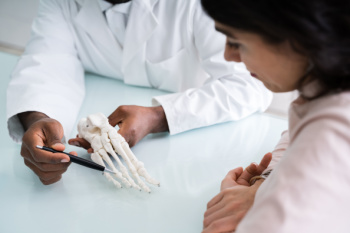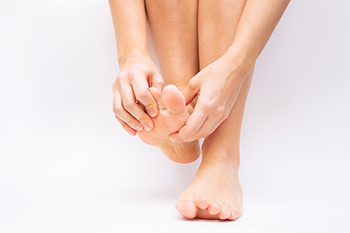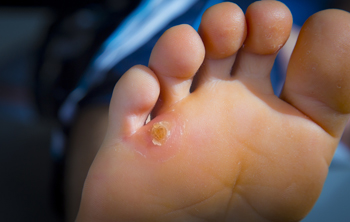March 2024
Types of Metatarsal Foot Fractures

Metatarsal fractures encompass a variety of injuries, from acute trauma to stress fractures in the five long bones of the feet. Acute metatarsal fractures occur suddenly, often due to forceful impact, like dropping a heavy object on it or sports-related incidents. These fractures can be open, where the skin is broken, or closed, and may be displaced, requiring realignment and stabilization by a podiatrist. The fifth metatarsal bone is particularly prone to acute fractures, commonly occurring at various points along its length. Stress fractures, on the other hand, develop gradually from repetitive pounding, resulting in hairline cracks that may be difficult to detect. However, they still require proper diagnosis and treatment to prevent worsening symptoms. Recognizing the signs of metatarsal fractures and seeking timely medical attention from a podiatrist is important. If you suspect a metatarsal fracture or experience midfoot pain it is suggested that you make an appointment with a podiatrist for an exam, diagnosis, and treatment options.
A broken foot requires immediate medical attention and treatment. If you need your feet checked, contact Dr. John C. Lawlor from Florida. Our doctor can provide the care you need to keep you pain-free and on your feet.
Broken Foot Causes, Symptoms, and Treatment
A broken foot is caused by one of the bones in the foot typically breaking when bended, crushed, or stretched beyond its natural capabilities. Usually the location of the fracture indicates how the break occurred, whether it was through an object, fall, or any other type of injury.
Common Symptoms of Broken Feet:
- Bruising
- Pain
- Redness
- Swelling
- Blue in color
- Numbness
- Cold
- Misshapen
- Cuts
- Deformities
Those that suspect they have a broken foot shoot seek urgent medical attention where a medical professional could diagnose the severity.
Treatment for broken bones varies depending on the cause, severity and location. Some will require the use of splints, casts or crutches while others could even involve surgery to repair the broken bones. Personal care includes the use of ice and keeping the foot stabilized and elevated.
If you have any questions please feel free to contact one of our our offices located in Cape Coral and LaBelle, FL . We offer the newest diagnostic and treatment technologies for all your foot and ankle needs.
What Podiatrists Do

Podiatrists are healthcare professionals specializing in diagnosing, treating, and preventing conditions affecting the feet, ankles, and lower extremities. They provide comprehensive care for foot-related issues, including injuries, deformities, infections, and chronic conditions like diabetes. Podiatrists can help people of all ages, from children to the elderly, offering services such as routine foot care, orthotic prescriptions, wound care, and surgical interventions when necessary. Unlike medical doctors, MDs, who focus on the entire body, podiatrists, DPMs, focus exclusively on the lower extremities, allowing them to develop specialized expertise in foot and ankle care. Their training includes four years of podiatric medical school followed by residency programs, equipping them with the knowledge and skills to address a wide range of podiatric issues effectively. If you are experiencing foot pain, discomfort, or any abnormalities in foot structure or function, it is suggested that you make an appointment with a podiatrist for a diagnosis and treatment.
If you are dealing with pain in your feet and ankles, you may want to seek help from a podiatrist. Feel free to contact Dr. John C. Lawlor from Florida. Our doctor can provide the care you need to keep you pain-free and on your feet.
What Is a Podiatrist?
A podiatrist is a doctor of podiatric medicine who diagnoses and treats conditions of the foot, ankle, and related structures of the leg. Your podiatrist may specialize in a certain field such as sports medicine, wound care, pediatrics, and diabetic care. Podiatrists have the ability to become board certified through training, clinical experience, and then taking an exam.
What Do Podiatrists Do?
On a daily basis, a podiatrist may perform the following activities:
- Diagnose foot ailments such as ulcers, tumors, fractures, etc.
- Use innovative methods to treat conditions
- Use corrective orthotics, casts, and strappings to correct deformities
- Correct walking patterns and balance
- Provide individual consultations to patients
It is very important that you take care of your feet. It’s easy to take having healthy feet for granted, however foot problems tend to be among the most common health conditions. Podiatrists can help diagnose and treat a variety of feet related conditions, so it is crucial that you visit one if you need assistance.
If you have any questions please feel free to contact one of our our offices located in Cape Coral and LaBelle, FL . We offer the newest diagnostic and treatment technologies for all your foot and ankle needs.
Causes of Big Toe Stiffness

The big toe, or hallux, is more than just a digit on your foot. It's essential for your daily activities, like walking, standing, and maintaining balance. However, stiffness in the big toe can severely impact mobility and comfort. Big toe stiffness, medically known as hallux rigidus, can stem from various factors. Most cases are of unknown origin, while others result from injuries damaging the joint's cartilage. Structural changes, like a shifted or bent first metatarsal, or even genetic predispositions, can contribute to its development. Additionally, conditions such as osteoarthritis, gout, or bunions can increase the risk of big toe stiffness. Pain, swelling, and redness around the joint, along with stiffness and reduced range of motion, are common symptoms. If you're experiencing symptoms of big toe stiffness, it's suggested that you make an appointment with a podiatrist, who can offer the appropriate treatment option.
Toe pain can disrupt your daily activities. If you have any concerns, contact Dr. John C. Lawlor of Florida. Our doctor can provide the care you need to keep you pain-free and on your feet.
What Causes Toe Pain?
Most severe toe pain is caused due to a sports injury, trauma from dropping something heavy on the toe, or bumping into something rigid. Other problems can develop over time for various reasons.
Toe pain can be caused by one or more ailments. The most common include:
- Trauma
- Sports injury
- Wearing shoes that are too tight
- Arthritis
- Gout
- Corns and calluses
- Hammertoe
- Bunions
- Blisters
- Ingrown toenails
- Sprains
- Fractures (broken bones)
- Dislocations
When to See a Podiatrist
- Severe pain
- Persistent pain that lasts more than a week
- Signs of infection
- Continued swelling
- Pain that prevents walking
Diagnosis
In many cases the cause of toe pain is obvious, but in others, a podiatrist may want to use more advanced methods to determine the problem. These can range from simple visual inspections and sensation tests to X-rays and MRI scans. Prior medical history, family medical history, and any recent physical traumatic events will all be taken into consideration for a proper diagnosis.
Treatment
Treatments for toe pain and injuries vary and may include shoe inserts, padding, taping, medicines, injections, and in some cases, surgery. If you believe that you have broken a toe, please see a podiatrist as soon as possible.
If you have any questions please feel free to contact one of our our offices located in Cape Coral and LaBelle, FL . We offer the newest diagnostic tools and technology to treat your foot and ankle needs.
Arthritis Can Cause Pain in the Feet and Ankles
Differences Between Calluses and Corns on the Feet
 Foot corns and calluses can have similar causes but are two different conditions often found on different parts of the feet. Both calluses and corns are areas of thickened skin caused by repeated friction or pressure. Calluses typically form on weight-bearing areas, like the soles of the feet, and are usually larger than corns. They are the skin's natural response to protect against excessive pressure. On the other hand, corns tend to be smaller and have a more concentrated core. They often develop on non-weight-bearing areas, such as the tops or sides of toes. Corns result also from friction or pressure, and ill-fitting shoes or toe deformities can contribute. While calluses and corns are generally harmless, they can become painful or problematic. If you suspect a corn or callus on your foot, it is suggested you seek diagnosis and treatment advice from a podiatrist.
Foot corns and calluses can have similar causes but are two different conditions often found on different parts of the feet. Both calluses and corns are areas of thickened skin caused by repeated friction or pressure. Calluses typically form on weight-bearing areas, like the soles of the feet, and are usually larger than corns. They are the skin's natural response to protect against excessive pressure. On the other hand, corns tend to be smaller and have a more concentrated core. They often develop on non-weight-bearing areas, such as the tops or sides of toes. Corns result also from friction or pressure, and ill-fitting shoes or toe deformities can contribute. While calluses and corns are generally harmless, they can become painful or problematic. If you suspect a corn or callus on your foot, it is suggested you seek diagnosis and treatment advice from a podiatrist.
Corns can make walking very painful and should be treated immediately. If you have questions regarding your feet and ankles, contact Dr. John C. Lawlor of Florida. Our doctor will treat your foot and ankle needs.
Corns: What Are They? And How Do You Get Rid of Them?
Corns are thickened areas on the skin that can become painful. They are caused by excessive pressure and friction on the skin. Corns press into the deeper layers of the skin and are usually round in shape.
Ways to Prevent Corns
There are many ways to get rid of painful corns such as:
- Wearing properly fitting shoes that have been measured by a professional
- Wearing shoes that are not sharply pointed or have high heels
- Wearing only shoes that offer support
Treating Corns
Although most corns slowly disappear when the friction or pressure stops, this isn’t always the case. Consult with your podiatrist to determine the best treatment option for your case of corns.
If you have any questions please feel free to contact one of our our offices located in Cape Coral and LaBelle, FL . We offer the newest diagnostic and treatment technologies for all your foot and ankle needs.









